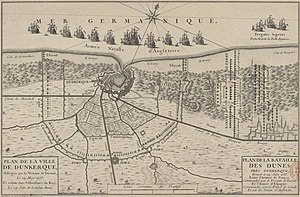Siege of Dunkirk (1658)
| Siege of Dunkirk | |||||||
|---|---|---|---|---|---|---|---|
| Part of the Franco-Spanish War and Anglo-Spanish War |
|||||||
 Map showing the Siege of Dunkirk and the Battle of the Dunes with the blockade of the English fleet in 1658 |
|||||||
|
|||||||
| Belligerents | |||||||
|
|
|
||||||
| Commanders and leaders | |||||||
|
|
|
||||||
| Strength | |||||||
| 12,000 infantry 8,000 cavalry 18 warships |
2,200 infantry 700-800 cavalry |
||||||
| Casualties and losses | |||||||
| 1,400 | |||||||
Anglo-French victory
The Siege of Dunkirk in 1658 was a military operation by the allied forces of France and Commonwealth England intended to take the fortified port city of Dunkirk, Spain's greatest privateer base, from the Spanish and their confederates: the English royalists and French Fronduers. Dunkirk (Dutch for 'Church in the dunes') was a strategic port on the southern coast of the English Channel in the Spanish Netherlands that had often been a point of contention previously and had changed hands a number of times. Privateers operating out of Dunkirk and other ports had cost England some 1,500 to 2,000 merchant ships in the past year. The French and their English Commonwealth allies were commanded by Marshal of France Turenne. The siege would last a month and featured numerous sorties by the garrison and a determined relief attempt by the Spanish army under the command of Don Juan of Austria and his confederate English royalists under Duke of York and rebels of the French Fronde under the Great Condé that resulted in the battle of the Dunes.
The French, in 1657, completed an alliance with the Lord Protector, Oliver Cromwell, in which the English Commonwealth would join in the war against Spain and supply troops and ships for a campaign in the Spanish Netherlands. In return, Cromwell made the support of a fleet and 6,000 soldiers conditional on the transfer of Dunkirk to the English once it had been taken. The treaty was renewed in 1658 and encouraged by the promised additions the French were early into the field capturing a contingent of Spanish troops in Cassel, marching by way of Bergues on Dunkirk.
Turenne, with some 7,000 men was impeded by the heavy seasonal rains and by the opening of the sluices by his opponents which inundated all the low-lying ground in the area. He had been advised that it would be impossible to bring artillery with him under these conditions, but he persisted and succeeded. Though often marching and wading through deep water holding their arms over their heads, French morale remained high and roads were made for their baggage and artillery. When Turenne reached the road at the dike at Bergues the Spanish were caught by surprise as they had assumed Turenne would make for Cambrai. The Spanish troops in the area, now under the command of the Marquis of Lede, acting as governor of Dunkirk during the siege, fell back into Dunkirk, raising the strength of the garrison to about 2,200 foot and 700 - 800 horse. The Duke of York was ordered with his English regiments along with other troops in the nearby areas to march and throw themselves into Dunkirk, but they arrived too late and James found Dunkirk already invested and fell back.
...
Wikipedia
